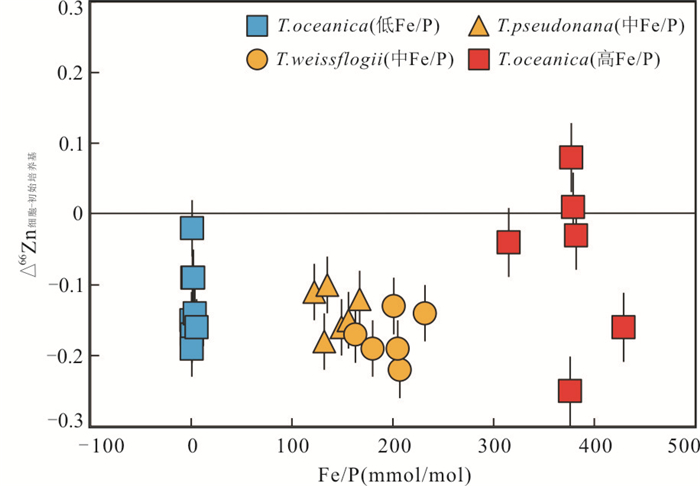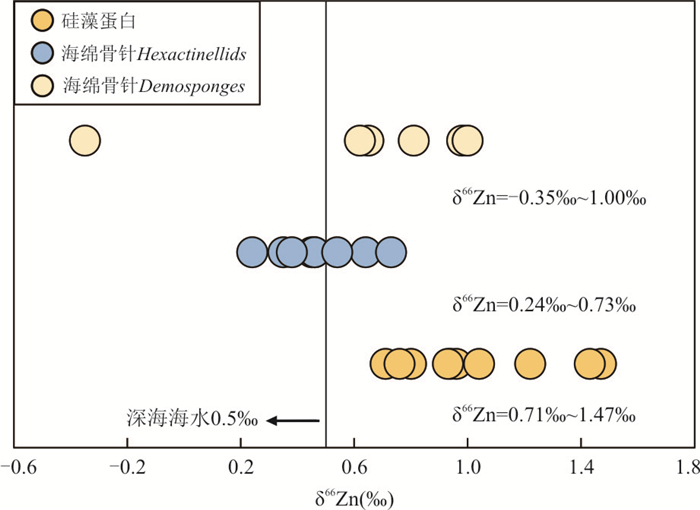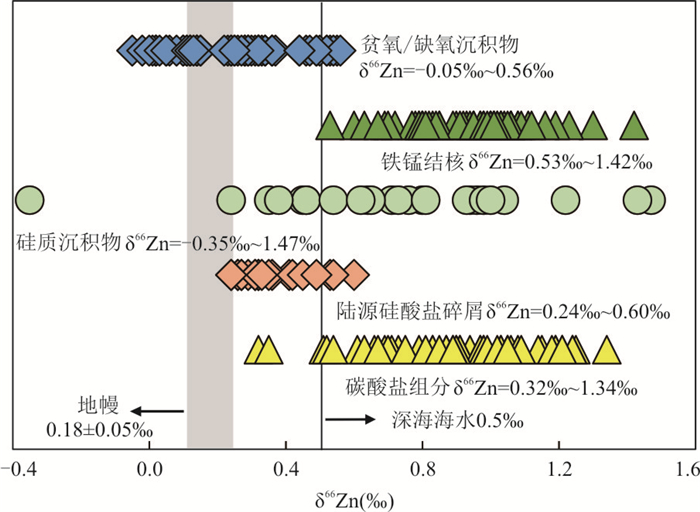Zinc Isotope Geochemistry of Marine Sediments and Its Applications: A Review
-
摘要: 锌同位素体系是海洋地球化学研究的新示踪剂,应用于示踪海水中锌元素的来源及其运移过程.海洋沉积物作为锌元素重要的"源"与/或"汇",其锌同位素组成的研究有助于理解海洋锌元素的地球化学循环.海洋沉积物记录了海水组成的信息,可以反演古海水锌同位素组成的变化,前提是理解沉积物与海水之间的分馏.对海水及海洋不同储库锌同位素研究进行系统总结,包括河流输入、热液体系、不同类型海洋沉积物(如富碳酸盐的沉积物、陆源硅酸盐碎屑、硅质沉积物、铁锰结核、贫氧-缺氧沉积物)的锌同位素组成,阐述了海洋沉积物锌同位素组成变化在古气候、古环境重建以及古海洋学等领域的应用以及重要性.Abstract: Zinc isotope represents new tracers of oceanography, which is used to trace the source and migration of zinc in seawater. As important sources and/or sinks of zinc, the study of zinc isotopic composition of marine sediments is of great significance to our understanding of geochemical cycling of zinc. In addition, marine sediments record the composition of seawater, and the study of zinc isotope fractionation between marine sediments and seawater is a prerequisite for tracing zinc isotopic composition of ancient seawater. In this paper, researches on zinc isotopes of seawater and reservoirs in the ocean are systematically summarized, including zinc isotope study of riverine inputs, hydrothermal systems and different types of marine sediments (carbonate-rich sediments, terrigenous silicate fragments, siliceous sediments, ferromanganese nodules and suboxic/anoxic sediments), to explain the applications and importance of zinc isotope variations of marine sediments in paleoclimate, paleoenvironment and paleoceanography.
-
Key words:
- marine sediment /
- Zn isotope /
- marine geochemical cycling /
- paleoclimate /
- geochemistry
-
图 1 不同种属硅藻细胞与初始培养基的Zn同位素分馏值与细胞内Fe/P比值关系
数据来源于Köbberich and Vance(2017, 2018)
Fig. 1. Zn isotope fractionation between biomass and the initial culturing medium (Δ66Zn), as observed for three different Thalassiosira strains with different Fe/P ratios
图 2 不同种类硅质沉积物的Zn同位素组成
数据来源于Andersen et al.(2011);Hendry and Andersen(2013)
Fig. 2. Zn isotopic composition of different types of siliceous sediments
图 3 海洋沉积物的锌同位素组成统计
数据来源于Maréchal et al.(2000);Pichat et al. (2003);Bermin et al. (2006);Andersen et al. (2011);Boyle et al. (2012);Hendry and Andersen (2013);Conway and John(2014, 2015);Little et al.(2014a, 2014b, 2016);Zhao et al. (2014);Vance et al.(2016, 2019);Samanta et al. (2017);Wang et al. (2017);John et al. (2018);McCoy-West et al. (2018);Sossi et al. (2018);Liu et al. (2019)
Fig. 3. A compilation of Zn isotopic composition of marine sediments
-
Andersen, M. B., Vance, D., Archer, C., et al., 2011. The Zn Abundance and Isotopic Composition of Diatom Frustules, a Proxy for Zn Availability in Ocean Surface Seawater. Earth and Planetary Science Letters, 301(1/2): 137-145. https://doi.org/10.1016/j.epsl.2010.10.032 Anderson, M. A., Morel, F. M. M., Guillard, R. R. L., 1978. Growth Limitation of a Coastal Diatom by Low Zinc Ion Activity. Nature, 276(5683): 70-71. https://doi.org/10.1038/276070a0 Armbrust, E. V., 2009. The Life of Diatoms in the World's Oceans. Nature, 459(7244): 185-192. https://doi.org/10.1038/nature08057 Bentahila, Y., Ben Othman, D., Luck, J. M., 2008. Strontium, Lead and Zinc Isotopes in Marine Cores as Tracers of Sedimentary Provenance: A Case Study around Taiwan Orogen. Chemical Geology, 248(1/2): 62-82. https://doi.org/10.1016/j.chemgeo.2007.10.024 Bermin, J., Vance, D., Archer, C., et al., 2006. The Determination of the Isotopic Composition of Cu and Zn in Seawater. Chemical Geology, 226(3/4): 280-297. https://doi.org/10.1016/j.chemgeo.2005.09.025 Boyle, E. A., John, S., Abouchami, W., et al., 2012. GEOTRACES IC1 (BATS) Contamination-Prone Trace Element Isotopes Cd, Fe, Pb, Zn, Cu, and Mo Intercalibration. Limnology and Oceanography: Methods, 10(9): 653-665. https://doi.org/10.4319/lom.2012.10.653 Brand, L. E., Sunda, W. G., Guillard, R. R. L., 1983. Limitation of Marine Phytoplankton Reproductive Rates by Zinc, Manganese, and Iron 1. Limnology and Oceanography, 28(6): 1182-1198. https://doi.org/10.4319/lo.1983.28.6.1182 Bruland, K. W., 1980. Oceanographic Distributions of Cadmium, Zinc, Nickel, and Copper in the North Pacific. Earth and Planetary Science Letters, 47(2): 176-198. https://doi.org/10.1016/0012-821X(80)90035-7 Chen, J., Gaillardet, J., Louvat, P., 2008. Zinc Isotopes in the Seine Rivers, France: A Probe of Anthropogenic Contamination. Environment Science & Technology, 42(17): 6484-6501. https://doi.org/10.1021/es800725z. Chen, J. B., Gaillardet, J., Dessert, C., et al., 2014. Zn Isotope Compositions of the Thermal Spring Waters of La Soufrière Volcano, Guadeloupe Island. Geochimica et Cosmochimica Acta, 127: 67-82. https://doi.org/10.1016/j.gca.2013.11.022 Chen, S., Liu, Y. C., Hu, J. Y., et al., 2015. Zinc Isotopic Compositions of NIST SRM 683 and Whole-Rock Reference Materials. Geostandards and Geoanalytical Research, 40(3): 417-432. https://doi.org/10.1111/j.1751-908X.2015.00377.x Conway, T. M., John, S. G., 2014. The Biogeochemical Cycling of Zinc and Zinc Isotopes in the North Atlantic Ocean. Global Biogeochemical Cycles, 28(10): 1111-1128. https://doi.org/10.1002/2014GB004862 Conway, T. M., John, S. G., 2015. The Cycling of Iron, Zinc and Cadmium in the North East Pacific Ocean— Insights from Stable Isotopes. Geochimica et Cosmochimica Acta, 164: 262-283. https://doi.org/10.1016/j.gca.2015.05.023 Dong, S. F., Wasylenki, L. E., 2016. Zinc Isotope Fractionation during Adsorption to Calcite at High and Low Ionic Strength. Chemical Geology, 447: 70-78. https://doi.org/10.1016/j.chemgeo.2016.10.031 Ellwood, M. J., van den Berg, C. M. G., 2000. Zinc Speciation in the Northeastern Atlantic Ocean. Marine Chemistry, 68(4): 295-306. https://doi.org/10.1016/S0304-4203(99)00085-7 Fernandez, A., Borrok, D. M., 2009. Fractionation of Cu, Fe, and Zn Isotopes during the Oxidative Weathering of Sulfide-Rich Rocks. Chemical Geology, 264(1/2/3/4): 1-12. https://doi.org/10.1016/j.chemgeo.2009.01.024 Fujii, T., Moynier, F., Pons, M. L., et al., 2011. The Origin of Zn Isotope Fractionation in Sulfides. Geochimica et Cosmochimica Acta, 75(23): 7632-7643. https://doi.org/10.1016/j.gca.2011.09.036 Fujii, T., Moynier, F., Telouk, P., et al., 2010. Experimental and Theoretical Investigation of Isotope Fractionation of Zinc between Aqua, Chloro, and Macrocyclic Complexes. The Journal of Physical Chemistry A, 114(7): 2543-2552. https://doi.org/10.1021/jp908642f Gélabert, A., Pokrovsky, O. S., Viers, J., et al., 2006. Interaction between Zinc and Freshwater and Marine Diatom Species: Surface Complexation and Zn Isotope Fractionation. Geochimica et Cosmochimica Acta, 70(4): 839-857. https://doi.org/10.1016/j.gca.2005.10.026 Harrison, G. I., Morel, F. M. M., 1986. Response of the Marine Diatom Thalassiosira Weissflogii to Iron Stress 1. Limnology and Oceanography, 31(5): 989-997. https://doi.org/10.4319/lo.1986.31.5.0989 Hein, J. R., Mizell, K., Koschinsky, A., et al., 2013. Deep-Ocean Mineral Deposits as a Source of Critical Metals for High- and Green-Technology Applications: Comparison with Land-Based Resources. Ore Geology Reviews, 51: 1-14. https://doi.org/10.1016/j.oregeorev.2012.12.001 Hendry, K. R., Andersen, M. B., 2013. The Zinc Isotopic Composition of Siliceous Marine Sponges: Investigating Nature's Sediment Traps. Chemical Geology, 354: 33-41. https://doi.org/10.1016/j.chemgeo.2013.06.025 John, S. G., Geis, R. W., Saito, M. A., et al., 2007. Zinc Isotope Fractionation during High-Affinity and Low-Affinity Zinc Transport by the Marine Diatom Thalassiosira Oceanica. Limnology and Oceanography, 52(6): 2710-2714. https://doi.org/10.4319/lo.2007.52.6.2710 John, S. G., Helgoe, J., Townsend, E., 2018. Biogeochemical Cycling of Zn and Cd and Their Stable Isotopes in the Eastern Tropical South Pacific. Marine Chemistry, 201: 256-262. https://doi.org/10.1016/j.marchem.2017.06.001 John, S. G., Kunzmann, M., Townsend, E. J., et al., 2017. Zinc and Cadmium Stable Isotopes in the Geological Record: A Case Study from the Post-Snowball Earth Nuccaleena Cap Dolostone. Palaeogeography, Palaeoclimatology, Palaeoecology, 466: 202-208. https://doi.org/10.1016/j.palaeo.2016.11.003 John, S. G., Rouxel, O. J., Craddock, P. R., et al., 2008. Zinc Stable Isotopes in Seafloor Hydrothermal Vent Fluids and Chimneys. Earth and Planetary Science Letters, 269(1-2): 17-28. https://doi.org/10.1016/j.epsl.2007.12.011 Köbberich, M., Vance, D., 2017. Kinetic Control on Zn Isotope Signatures Recorded in Marine Diatoms. Geochimica et Cosmochimica Acta, 210: 97-113. https://doi.org/10.1016/j.gca.2017.04.014 Köbberich, M., Vance, D., 2018. Zinc Association with Surface-Bound Iron-Hydroxides on Cultured Marine Diatoms: A Zinc Stable Isotope Perspective. Marine Chemistry, 202: 1-11. https://doi.org/10.1016/j.marchem.2018.01.002 Kunzmann, M., Halverson, G. P., Sossi, P. A., et al., 2013. Zn Isotope Evidence for Immediate Resumption of Primary Productivity after Snowball Earth. Geology, 41(1): 27-30. https://doi.org/10.1130/g33422.1 Liang, L. L., Liu, C. Q., Zhu, X. K., et al., 2020. Zinc Isotope Characteristics in the Biogeochemical Cycle as Revealed by Analysis of Suspended Particulate Matter (SPM) in Aha Lake and Hongfeng Lake, Guizhou, China. Journal of Earth Science, 31(1): 126-140. https://doi.org/10.1007/s12583-017-0957-8 Little, S. H., Sherman, D. M., Vance, D., et al., 2014a. Molecular Controls on Cu and Zn Isotopic Fractionation in Fe-Mn Crusts. Earth and Planetary Science Letters, 396: 213-222. https://doi.org/10.1016/j.epsl.2014.04.021 Little, S. H., Vance, D., Walker-Brown, C., et al., 2014b. The Oceanic Mass Balance of Copper and Zinc Isotopes, Investigated by Analysis of Their Inputs, and Outputs to Ferromanganese Oxide Sediments. Geochimica et Cosmochimica Acta, 125: 673-693. https://doi.org/10.1016/j.gca.2013.07.046 Little, S. H., Vance, D., McManus, J., et al., 2016. Key Role of Continental Margin Sediments in the Oceanic Mass Balance of Zn and Zn Isotopes. Geology, 44(3): 207-210. https://doi.org/10.1130/g37493.1 Liu, S. A., Wu, H. C., Shen, S. Z., et al., 2017. Zinc Isotope Evidence for Intensive Magmatism Immediately before the End-Permian Mass Extinction. Geology, 45(4): 343-346. https://doi.org/10.1130/g38644.1 Liu, S. G., Liu, P. P., Lv, Y., et al., 2019. Cu and Zn Isotope Fractionation during Oceanic Alteration: Implications for Oceanic Cu and Zn Cycles. Geochimica et Cosmochimica Acta, 257: 191-205. https://doi.org/10.1016/j.gca.2019.04.026 Liu, Y. H., Gao, T., Xia, Y. F., et al., 2020. Using Zn Isotopes to Trace Zn Sources and Migration Pathways in Paddy Soils around Mining Area. Environmental Pollution, 267: 115616. https://doi.org/10.1016/j.envpol.2020.115616 Lohan, M. C., Statham, P. J., Crawford, D. W., 2002. Total Dissolved Zinc in the Upper Water Column of the Subarctic North East Pacific. Deep Sea Research Part II: Topical Studies in Oceanography, 49(24/25): 5793-5808. https://doi.org/10.1016/S0967-0645(02)00215-1 Lv, Y., Liu, S. G., Wu, H. C., et al., 2018. Zn-Sr Isotope Records of the Ediacaran Doushantuo Formation in South China: Diagenesis Assessment and Implications. Geochimica et Cosmochimica Acta, 239: 330-345. https://doi.org/10.1016/j.gca.2018.08.003 Maréchal, C. N., Nicolas, E., Douchet, C., et al., 2000. Abundance of Zinc Isotopes as a Marine Biogeochemical Tracer. Geochemistry, Geophysics, Geosystems, 1(5): 1015. https://doi.org/10.1029/1999GC000029 Martin, J. H., Gordon, R. M., Fitzwater, S., et al., 1989. Vertex: Phytoplankton/Iron Studies in the Gulf of Alaska. Deep Sea Research Part A Oceanographic Research Papers, 36(5): 649-680. https://doi.org/10.1016/ 0198-0149(89)90144-1 doi: 10.1016/0198-0149(89)90144-1 Mavromatis, V., González, A. G., Dietzel, M., et al., 2019. Zinc Isotope Fractionation during the Inorganic Precipitation of Calcite-Towards a New pH Proxy. Geochimica et Cosmochimica Acta, 244: 99-112. https://doi.org/10.1016/j.gca.2018.09.005 Mccoy-West, A. J., Fitton, J. G., Pons, M. L., et al., 2018. The Fe and Zn Isotope Composition of Deep Mantle Source Regions: Insights from Baffin Island Picrites. Geochimica et Cosmochimica Acta, 238: 542-562. https://doi.org/10.1016/j.gca.2018.07.021 Morel, F. M. M., Milligan, A.J., Saito, M. A., 2014. Marine Bioinorganic Chemistry: The Role of Trace Metals in the Oceanic Cycles of Major Nutrients. Treatise on Geochemistry (Second Edition), 8: 123-150. https://doi.org/10.1016/B0-08-043751-6/06108-9. Morel, F. M. M., Reinfelder, J. R., Roberts, S. B., et al., 1994. Zinc and Carbon Co-Limitation of Marine Phytoplankton. Nature, 369(6483): 740-742. https://doi.org/10.1038/369740a0 Moynier, F., Vance, D., Fujii, T., et al., 2017. The Isotope Geochemistry of Zinc and Copper. Reviews in Mineralogy and Geochemistry, 82(1): 543-600. https://doi.org/10.2138/rmg.2017.82.13 Pichat, S., Douchet, C., Albarède, F., 2003. Zinc Isotope Variations in Deep-Sea Carbonates from the Eastern Equatorial Pacific over the Last 175 ka. Earth and Planetary Science Letters, 210(1/2): 167-178. https://doi.org/10.1016/S0012-821X(03)00106-7 Pokrovsky, O. S., Pokrovski, G. S., Gélabert, A., et al., 2005. Speciation of Zn Associated with Diatoms Using X-Ray Absorption Spectroscopy. Environmental Science & Technology, 39(12): 4490-4498. https://doi.org/10.1021/es0480419 Reiswig, H. M., 1971. Particle Feeding in Natural Populations of Three Marine Demosponges. The Biological Bulletin, 141(3): 568-591. https://doi.org/10.2307/1540270 Samanta, M., Ellwood, M. J., Sinoir, M., et al., 2017. Dissolved Zinc Isotope Cycling in the Tasman Sea, SW Pacific Ocean. Marine Chemistry, 192: 1-12. https://doi.org/10.1016/j.marchem.2017.03.004 Shaked, Y., Xu, Y., Leblanc, K., et al., 2006. Zinc Availability and Alkaline Phosphatase Activity in Emiliania Huxleyi: Implications for Zn-P Co-Limitation in the Ocean. Limnology and Oceanography, 51(1): 299-309. https://doi.org/10.4319/lo.2006.51.1.0299 Shields, W. R., Murphy, T. J., Garner, E. L., 1964. Absolute Isotopic Abundance Ratio and the Atomic Weight of a Reference Sample of Copper. Journal of Research of the National Bureau of Standards Section A: Physics and Chemistry, 68A(6): 589-592. https://doi.org/10.6028/jres.068a.056 Sinoir, M., Butler, E. C. V., Bowie, A. R., et al., 2012. Zinc Marine Biogeochemistry in Seawater: A Review. Marine and Freshwater Research, 63(7): 644-657. https://doi.org/10.1071/mf11286 Sossi, P. A., Nebel, O., O'Neill, H. S. C., et al., 2018. Zinc Isotope Composition of the Earth and Its Behaviour during Planetary Accretion. Chemical Geology, 477: 73-84. https://doi.org/10.1016/j.chemgeo.2017.12.006 Sunda, W. G., Huntsman, S. A., 1992. Feedback Interactions between Zinc and Phytoplankton in Seawater. Limnology and Oceanography, 37(1): 25-40. https://doi.org/10.4319/lo.1992.37.1.0025 Sweere, T. C., Dickson, A. J., Jenkyns, H. C., et al., 2018. Isotopic Evidence for Changes in the Zinc Cycle during Oceanic Anoxic Event 2 (Late Cretaceous). Geology, 46(5): 463-466. https://doi.org/10.1130/g40226.1 Sweere, T. C., Dickson, A. J., Jenkyns, H. C., et al., 2020. Zinc- and Cadmium-Isotope Evidence for Redox-Driven Perturbations to Global Micronutrient Cycles during Oceanic Anoxic Event 2 (Late Cretaceous). Earth and Planetary Science Letters, 546: 116427. https://doi.org/10.1016/j.epsl.2020.116427 Twining, B. S., Baines, S. B., 2013. The Trace Metal Composition of Marine Phytoplankton. Annual Review of Marine Science, 5(1): 191-215. https://doi.org/10.1146/annurev-marine-121211-172322 United States National Research Council, 2000. Zinc, in Dietary Reference Intakes for Vitamin A, Vitamin K, Arsenic, Boron, Chromium, Copper, Iodine, Iron, Manganese, Molybdenum, Nickel, Silicon, Vanadium, and Zinc. National Academy Press, Washington, D.C., 442-501. Vance, D., de Souza, G. F., Zhao, Y., et al., 2019. The Relationship between Zinc, Its Isotopes, and the Major Nutrients in the North-East Pacific. Earth and Planetary Science Letters, 525: 115748. https://doi.org/10.1016/j.epsl.2019.115748 Vance, D., Little, S. H., Archer, C., et al., 2016. The Oceanic Budgets of Nickel and Zinc Isotopes: The Importance of Sulfidic Environments as Illustrated by the Black Sea. Philosophical Transactions of the Royal Society A: Mathematical, Physical and Engineering Sciences, 374(2081): 20150294. https://doi.org/10.1098/rsta.2015.0294 Vance, D., Little, S. H., de Souza, G. F., et al., 2017. Silicon and Zinc Biogeochemical Cycles Coupled through the Southern Ocean. Nature Geoscience, 10(3): 202-206. https://doi.org/10.1038/ngeo2890 Wang, X., Liu, S. G., Wang, Z. R., et al., 2018. Zinc and Strontium Isotope Evidence for Climate Cooling and Constraints on the Frasnian-Famennian (~372 Ma) Mass Extinction. Palaeogeography, Palaeoclimatology, Palaeoecology, 498: 68-82. https://doi.org/10.1016/j.palaeo.2018.03.002 Wang, Y., Zhu, X.K., 2010. Application of Zn Isotopes to Study of Mineral Deposits: A Review. Mineral Deposits, 29(5): 843-852 (in Chinese with English abstract). http://www.researchgate.net/publication/309698136_Application_of_Zn_isotopes_to_study_of_mineral_deposits_A_review_in_Chinese Wang, Z.X., Liu, S. A., Li, M.L., et al., 2020. Advances on Application of Zinc Isotope as a Tracer for Deep Carbon Cycles. Earth Science, 45(6): 1967-1976 (in Chinese with English abstract). https://doi.org/10.3799/dqkx.2020.159 Wang, Z. Z., Liu, S. G., Liu, J. G., et al., 2017. Zinc Isotope Fractionation during Mantle Melting and Constraints on the Zn Isotope Composition of Earth's Upper Mantle. Geochimica et Cosmochimica Acta, 198: 151-167. https://doi.org/10.1016/j.gca.2016.11.014 Yan, B., Zhu, X. K., He, X. X., et al., 2019. Zn Isotopic Evolution in Early Ediacaran Ocean: A Global Signature. Precambrian Research, 320: 472-483. https://doi.org/10.1016/j.precamres.2018.11.021 Yang, Y. H., Zhang, X. C., Liu, S. A., et al., 2018. Calibrating NIST SRM 683 as a New International Reference Standard for Zn Isotopes. Journal of Analytical Atomic Spectrometry, 33(10): 1777-1783. https://doi.org/10.1039/c8ja00249e Zimmermann, T., Mohamed, A. F., Reese, A., et al., 2020. Zinc Isotopic Variation of Water and Surface Sediments from the German Elbe River. Science of the Total Environment, 707: 135219. https://doi.org/10.1016/j.scitotenv.2019.135219 Zhao, M. Y., Tarhan, L. G., Zhang, Y. Y., et al., 2021. Evaluation of Shallow-Water Carbonates as a Seawater Zinc Isotope Archive. Earth and Planetary Science Letters, 553: 116599. https://doi.org/10.1016/j.epsl.2020.116599 Zhao, Y., Vance, D., Abouchami, W., et al., 2014. Biogeochemical Cycling of Zinc and Its Isotopes in the Southern Ocean. Geochimica et Cosmochimica Acta, 125: 653-672. https://doi.org/10.1016/j.gca.2013.07.045 王跃, 朱祥坤, 2010. 锌同位素在矿床学中的应用: 认识与进展. 矿床地质, 29(5): 843-852. doi: 10.3969/j.issn.0258-7106.2010.05.007 王照雪, 刘盛遨, 李孟伦, 等, 2020. 深部碳循环的锌同位素示踪研究进展. 地球科学, 45(6): 1967-1976. doi: 10.3799/dqkx.2020.159 -










 下载:
下载:



